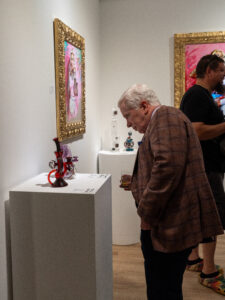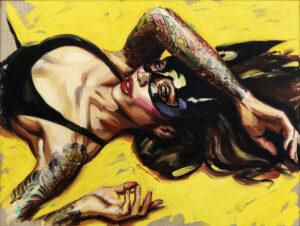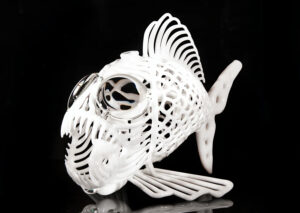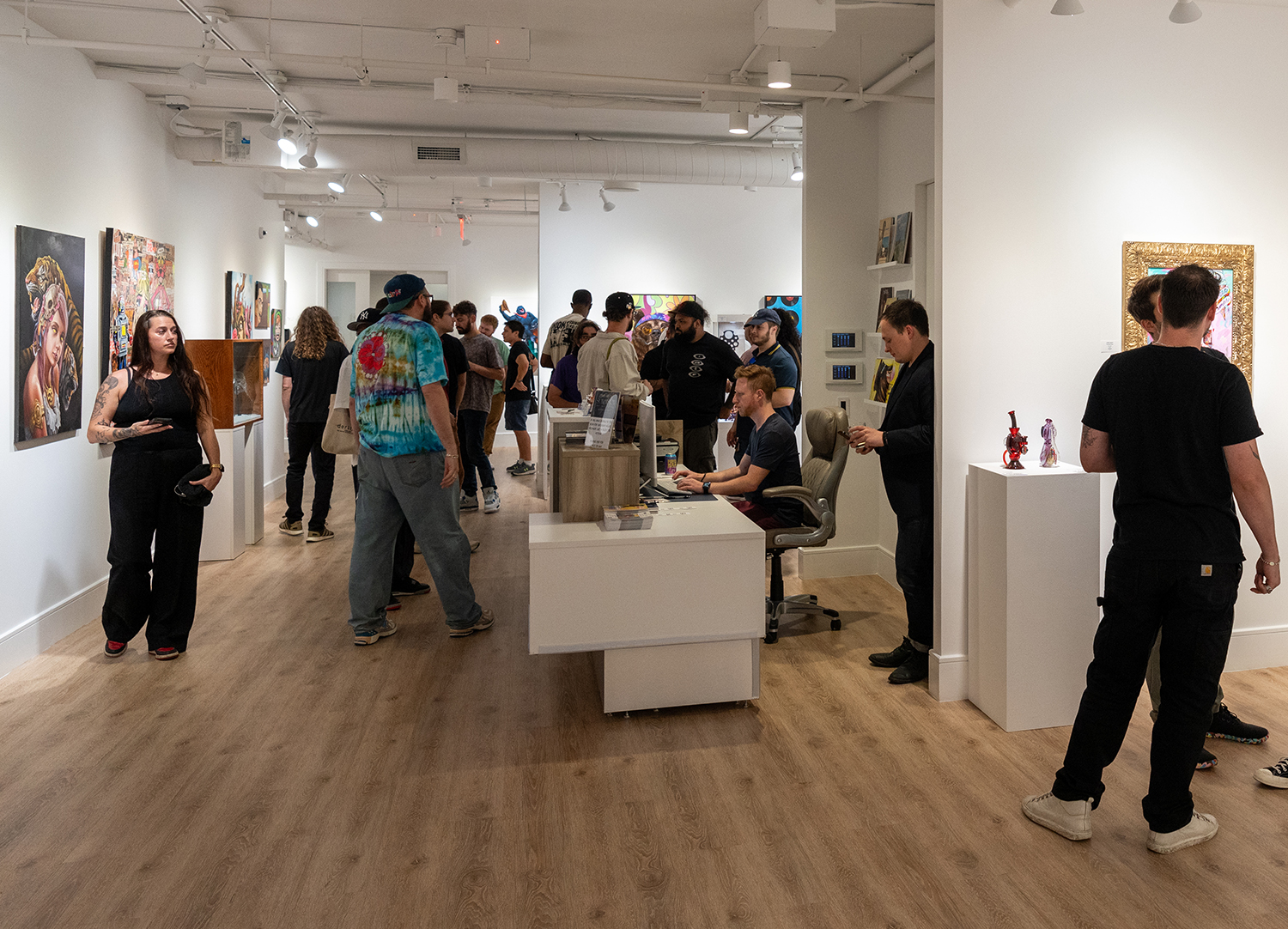Last Friday, September 13th, Rehs Contemporary Galleries opened their exhibition, The Art of Subversion. While the show has a coherent aesthetic, it may not be easy to nail down the goal of curating such an exhibition. Simply viewing the work online would not explain why street art-inspired paintings are displayed alongside pieces of functional glass sculpture. What do they mean by subversion, and why is it essential enough to dedicate an entire gallery show? Subversion, in this context, refers to highlighting and appreciating taboos and stigmas within the arts and beyond, including graffiti, tattoos, functional glass art, and other subjects and media. Not only is the exhibition applying a magnifying glass to subversive art, but in doing so, the exhibition itself is an act of subversion. The goal of The Art of Subversion at Rehs Contemporary is to offer the platform and vehicle of a gallery setting to subjects and genres that, in the past and even today, are unwelcome in such spaces.
Street art is probably the main source of inspiration for the graphic art on display. Conversations surrounding street art are incredibly nuanced and have evolved greatly over the past decade. Until Banksy became a household name, brick walls and overpasses in the world’s urban centers were where you would find the best street art and graffiti, not on the auction block at Christie’s. Of course, street art has inspired or served as a starting point for some of the great modern artists of the last fifty years, most notably Keith Haring and Jean-Michel Basquiat. However, until Banksy, street artists had to move off the street and into a studio to gain greater legitimacy, success, and name recognition. Yet despite the success of Banksy and the incorporation of street art and graffiti into contemporary art collecting and connoisseurship, there is still work that must be done. Many in the worldwide street art scene have commented that there is still room for greater normalization and legitimization. Banksy is sometimes seen not as a forerunner of greater change but as merely a prominent graffiti artist for whom society and law enforcement make an exception. Works by world-famous street artists are preserved and admired, while others are covered and painted over. One incident last year in Glasgow clearly showed this double standard when a piece of graffiti was only painted over after the local council learned it was, in fact, not by Banksy but by a duo seeking to imitate the anonymous artist’s style. Some towns and cities are already providing designated spaces where graffitists can work freely. So, allowing street artists to exhibit their work in a gallery provides legitimacy, eases the stigma against graffiti, and brings these artists’ work to an entirely different audience.
Among the artists represented in The Art of Subversion, Chris Guest pulls from a very different art form that mainstream fine art spaces also exclude. Scantily clad and nude women are nothing new in traditional Western art. However, graphic art that is more sexually explicit, like pinups and erotica, has always had a hard time breaking through, regardless of the artist’s skill. Guest captures the subjects and aesthetics of centerfold photographs and other genres dismissed as smut using the traditional medium of oil paints on canvas. Furthermore, while academic nude painting shows idealized proportions and perfectly clear skin, Guest subverts the genre of conventional figure painting by using subjects with elaborate tattoos. This brings us to another taboo addressed in The Art of Subversion. Though tattoos are becoming more widely accepted and of great cultural significance among some peoples, like the Maori of New Zealand, tattoos are often associated with outcasts and other marginalized groups. In many cultures, it is associated with criminality, especially in places like Japan, where the practice is closely associated with organized crime. But even in times and places where tattoos were nearly completely kept on the periphery, those at the center of high society couldn’t help themselves. Despite the taboo, European royals often got tattoos while traveling abroad. King Edward VII of England and his son King George V each had a five-fold cross tattooed on their arms, both done by the same tattoo artist in Jerusalem about twenty years apart. While on a trip to Japan, Czar Nicholas II had a dragon tattooed on his right arm, which can be seen in some photos. Exceptions like these show that long-standing stigmas that still persist today are never as cut and dry as they seem.
As I’ve discussed in a previous article, the difference between what is and is not fine art often concerns purpose. Many beautiful pieces are excluded from the fine art category because they have a practical, useful role. Jewelry, pottery, ceramics, textiles, and glass are kept out of the fine art club. One of the central components of The Art of Subversion is functional glass sculpture. Not only has this form of art been excluded from gallery spaces because it has a practical purpose, but there is also the taboo associated with smoking culture that has only started to fade in the past decade or so because of cannabis decriminalization and legalization efforts. Many visitors reacted similarly to seeing these pieces: as beautiful and complex as some of these pieces are, the practical purpose almost seems secondary. This is most apparent in the work by Buck, Hamm Brushland-Vitrifex, and JP Toro. When placed in the right context, they are perceived more as genuine works of art than objects serving a practical function. This makes it an even greater shame that this sort of work is, in some jurisdictions, not just stigmatized but outright illegal and classified as drug paraphernalia. It only makes it more difficult for these incredibly skilled craftsmen to make a living.
Every once in a while, bringing in outsiders is the best way to breathe new life into any establishment. By exalting the marginalized, the stigmatized, and the subversive, we help push visual art into new and exciting directions by injecting it with experimentation and fresh perspectives. In a counterintuitive way, you need a little subversion to move forward.





